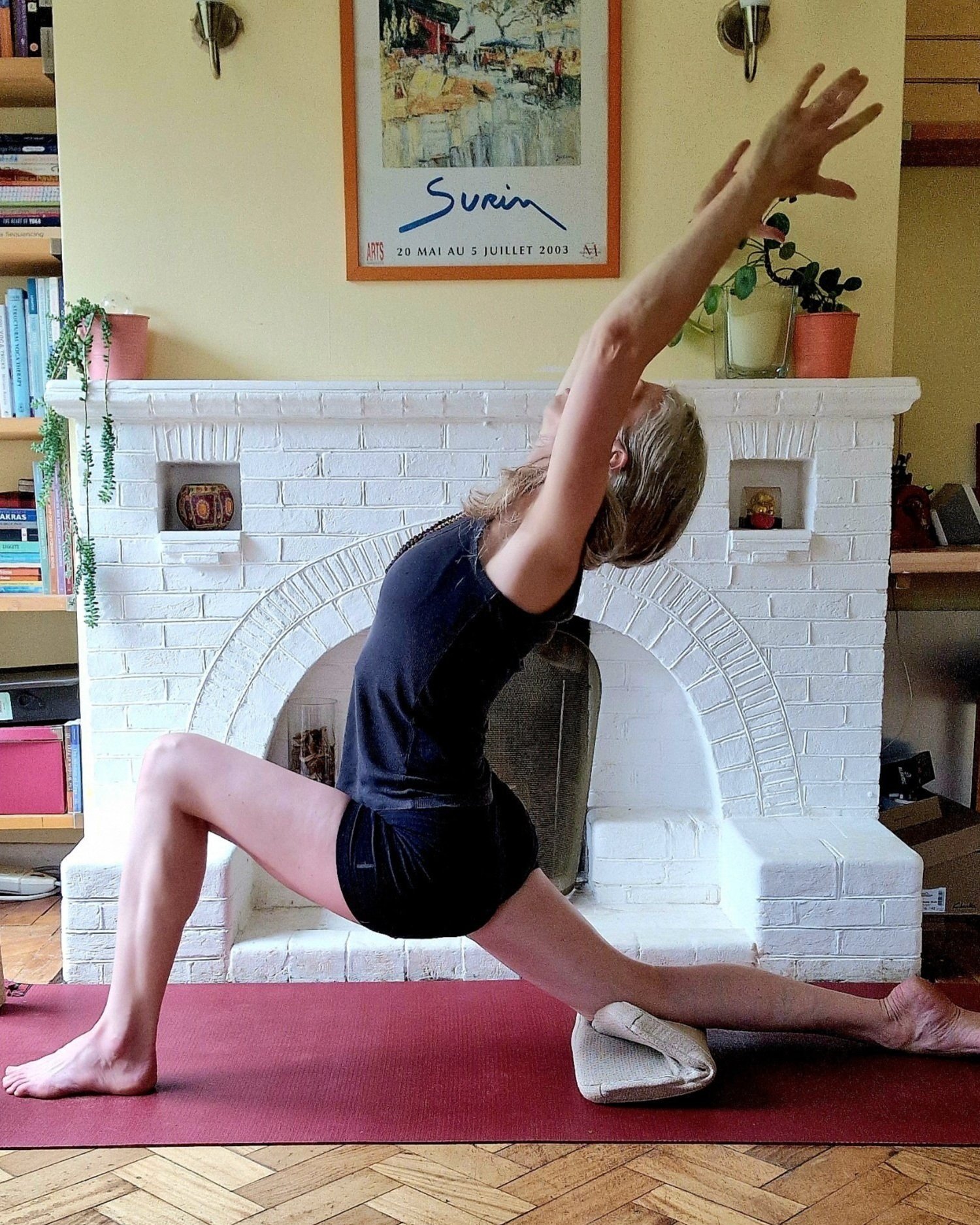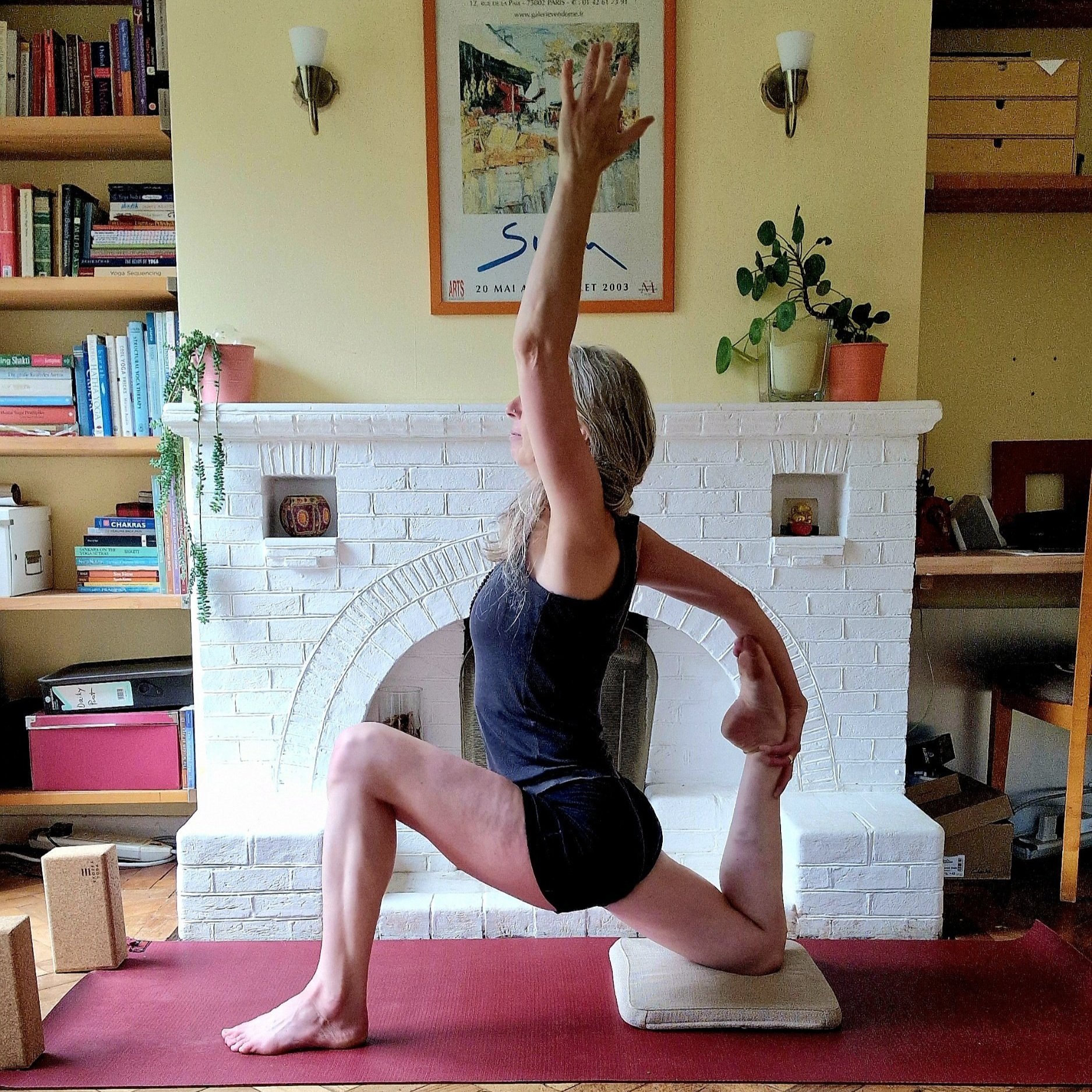Low Lunge (Anjaneyasana) – Open Your Hips & Ground Your Energy
Anjaneyasana is a deep lunge. It provides a powerful stretch to the back leg's front hip, quads, and iliopsoas. The front leg receives a different but still deep stretch and strength work.
What is Anjaneyasana?
Suppose you love Surya Namaskar or practise it regularly. In that case, you sure have come across low lunge or Anjaneyasana, also known as a half-crescent moon found in Chandra Namaskar, the salute to the moon.
It's a beautiful opening pose for the front of the thighs, hips, and chest.
Yogis of old recommended sattvic Food to practise with a calm Mind. Get your FREE Sattvic Shopping List.
Subscribe to our weekly Sunday Read newsletter & this Seasonal Living with Ayurveda & Yoga Blog.
The Story behind this Pose.
Anjaneyasana is one of the poses with a beautiful story behind it around baby Hanuman. It is similar to the story of Surya Namaskar but is slightly different.
These stories inspire you and help you relate to poses on a different level. They offer opportunities for reflection.
Anjaneyasana is named after a baby named Anjaneya. Anjaneya was born to a beautiful woman, Anjana, and the wind god, Vayu.
There are several stories about Anjana's character. However, she must have been a powerful yogini who performed tapas [maybe you remember the Niyama; tapas is one of them (purifying practices)].
One story goes the following way. Anjana desired to become a mother, and Lord Vayu heard this prayer. The story goes that Lord Vayu blessed a few grains of rice and sent them in the wind into the hands of Anjana. When Anjana felt the rice in her hands, she ate them and became pregnant, easy peasy.
Anjaneya was born and was half mortal and half divine. Being half divine, Anjaneya could soar into the sky. One day, he mistakenly tried to take a bite out of the sun, which he had mistaken for an orange!
This upset the sun god Surya, and he struck Anjaneya down with a lightning bolt, hitting him in the jaw and killing Anjaneya instantly.
When Vayu heard what had happened to his son, he was so furious that he sucked up all the air in the universe, and people could not breathe. An emergency meeting was held among the gods trying to restore order and peace back into the mortal and divine worlds. Vayu would not exhale all the air he had sucked in until he got his son, Anjaneya, back; however, Surya was concerned that the child was a danger to the world because of his precocious nature and godlike powers.
An agreement was made that Anjaneya would be renamed Hanuman and brought back to life, except that he would have short-term memory and be unable to remember his divinity, or godliness, long enough to cause harm.
Also, Hanuman would be removed from his mother's care and live with the respected monkey king, Sugriva. The little boy would also take the appearance of a monkey to blend in with his new family.
This is the story of Anjaneyasana or Crescent Lunge posture.
Like Anjaneya, this deep lung helps us stretch and test the limits, ours more so in the physical plane, in our body, specifically our hip flexor muscles (iliopsoas).
This is a combination of two muscles.
The psoas muscle originates from the lumber spine vertebrae and is joined by the iliopsoas from the pelvic crest onward. They then travel through the pelvis, passing the space between the hip joint and the pubic bones to insert into the inside of the femur (thigh bone)
How to enter Low Lunge.
Anjaneyasana can be accessed from Downward facing dog Adho mukha svanasana or from all-four/tabletop position.
Exhale step forward with your right leg.
Ensure that the knee is either directly above the ankle or behind it (towards the body).
The toes of the back foot (here, left foot) are either tucked under, or the top of the foot is flat on the floor.
If you enter from the Downward-Facing Dog pose, carefully lower your left knee to the floor.
Relax your pelvis down until you feel a comfortable stretch in the front of the left hip.
Inhale lift your torso upright. Keep both legs active, the front and top of the back foot pressing the floor away to steady your body.
Inhale lift your arms forward and up overhead. Pause and make sure your shoulders are happy; before you lift the arms even further up, let the top of the shoulders naturally rise up. Lift your chest and let the shoulder blades slide down against the torso toward mid-back.
Keep the legs strong and active, lift your chest even further, and reach your arms back if comfortable; if not, stay where you are. Let the little fingers reach to the sky.
Stay for 3 – 5 slow breaths.
Exhale lower your arms back down to the floor, and step your right foot back into Adho Mukha Svanasana.
Repeat on the left side.
What to look out for!
The knee is in a precarious position, for sure. So, if even padding the knees is not sufficient, try as an alternative sitting on a chair and lifting the 'front leg' to the chest or using the chair to support the front leg so it doesn't need to take any weight and take the other leg back.
As this pose is powerful and the opening of the front of the hip of the back leg is strong, make sure that your legs are active throughout the holding phase. Front and back foot pressing the floor away, both legs draw up into the respective hip joints and towards each other as if you would hold a block between the thighs.
Find the stability in this deeply grounding action of the legs to rise easily in this pose. Or for that matter, not only in the pose but in our creativity and spirituality.
Keep your spine long and your back evenly arched.
Benefits of Anjaneyasana!
The opening mentioned above of the front hip is definitely one of the main benefits of this pose. This opening balances the frequent sitting due to job, commute or other seated activities.
The deep lunge acts as a backbend as well. It brings all its benefits: energising, strengthening and mobilising the back, supporting shoulder mobility, strengthening the entire body, and stimulating digestion.
Lifting the chest and arms creates space for deeper breathing.
Practising Anjaneyasana is excellent preparation for backbends, especially the deeper ones like bow- and camel pose.
How to make Low Lunge easier.
Use a cushion underneath the back knee. It can be uncomfortable if the floor is hard; you can fold in your mat several times for more cushioning.
An alternative shoulder position could be cactus arms.
Use blocks to support the balance, and place your hands on a chair or table.
How to make Low Lunge more challenging?
Once you have mastered the pose, try to make it a little more challenging.
Bend your back knee; this will help open the front of the thighs and, quad muscles even more.
Rotate out the front leg at the hip to come into the lizard pose, Utthan Pristhasana.
! By patient, though, to avoid injuring yourself, make sure that your body is ready to go further. The best is always to practice with a teacher who can see and advise you.
How to practise Anjaneyasana through the seasons?
Anjaneyasana is excellent during the spring; opening the heart helps to shift excess Kapha in the chest area. The backbend helps with digestion. Hold longer.
In the summer, it helps to open, create a sense of space and let go of the intensity. Digestion benefits as well. In the summer evenings, it is great to practise it in the context of Chandra Namaskar to cool and ground the mind.
Autumn helps to focus and create grounding. Don’t hold too long; 3 deep, slow breaths are sufficient.
Final Thoughts!
Anjaneyasana, also known as Low Lunge or Crescent Lunge, is a powerful and transformative posture that provides a deep stretch to the thighs, groins, and chest.
Its origins in the story of Anjaneya add a deeper layer of meaning and inspiration to the practice. By practising Anjaneyasana, we can stretch and test the limits of our physical bodies, just as Anjaneya did in his journey.
This pose offers numerous benefits, including opening the front hips, improving posture, boosting energy, and preparing the body for deeper backbends.
Whether you're a beginner or an experienced yogi, incorporating Anjaneyasana into your practice can bring a sense of balance, strength, and grounding. So, embrace this wonderful pose and discover the transformative power it holds for your body, mind, and spirit.
Resources:
A Kaivalya and A. van der Kooij, Myths of the Asanas: The Stories at the Heart of the Yoga Tradition, San Rafael, CA: Mandala Publishing, 2010.
Iliopsoas picture by Ken Hub
Let me know if you find these tips helpful. You can leave a message on Instagram, Facebook or even good old email.
I love hearing from you!
Katja x
P.S. Be sure you download the Sattvic Shopping List to keep your mind calm during your Yoga practice and beyond!





